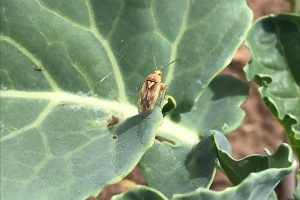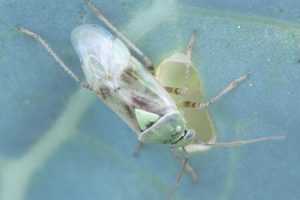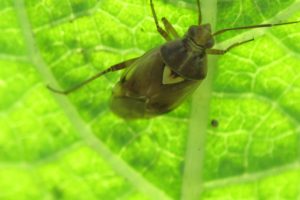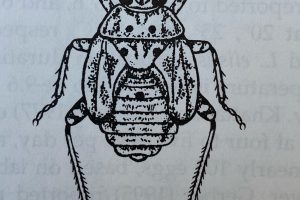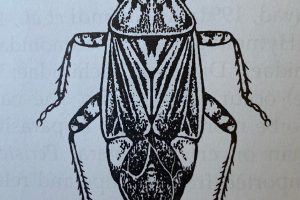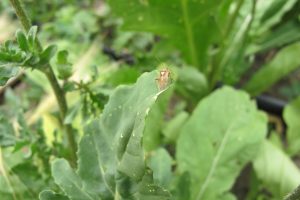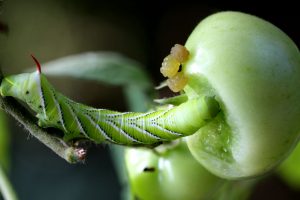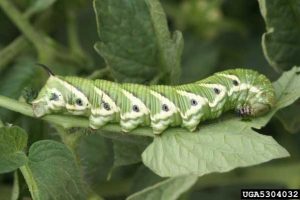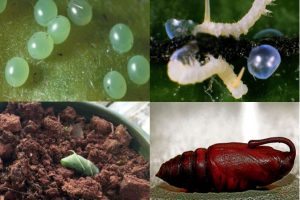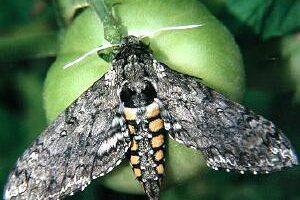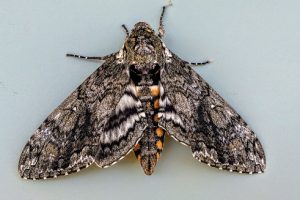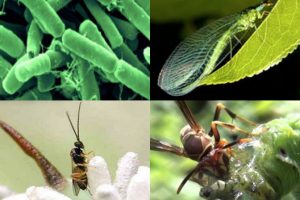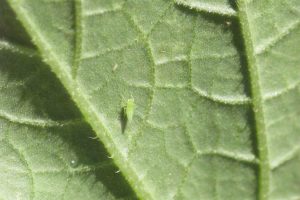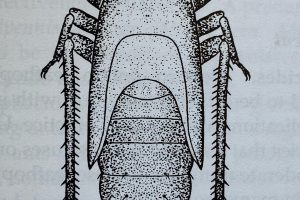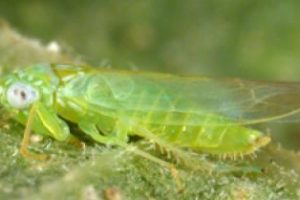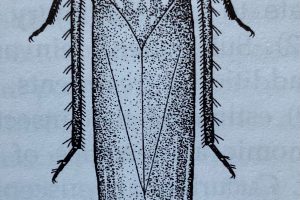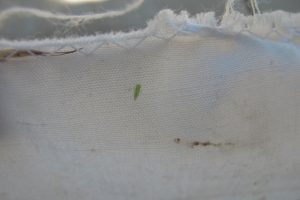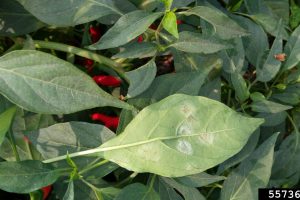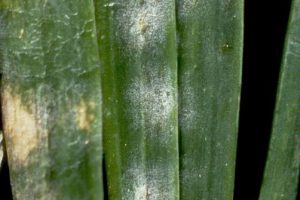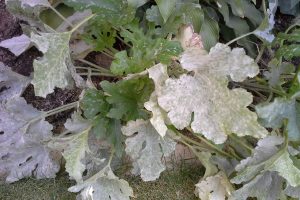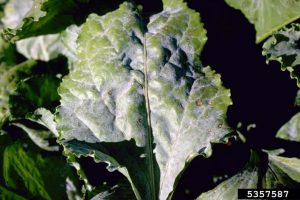Tarnished Plant Bugs
Occurrence: Active Now | Present throughout Utah, Minor Pest in Vegetable Crops
Description: The tarnished plant bug, Lygus lineolaris, is a true plant bug in the family Miridae. They are sometimes referred to as Lygus bugs. They are native to North America and are distributed throughout Mexico, United States, and Canada. The western tarnished plant bug, Lygus herperus, is closely related to the tarnished plant bug and has overlapping distributions in the western United States.
There are 2-4 generations in Utah. As with all true bugs, both nymphs and adults have piercing-sucking mouthparts. Adults seek shelter in the fall to overwinter and become active again in early spring.
Eggs are white, slightly curved, and about 1.7 mm long and 0.5 mm wide. Nymphs develop through five instars before becoming adults. Young nymphs are greenish with red antennae and can be confused for aphids. Adults average 4-6 mm in length, have dark, slender antennae, and obvious eyes. Like other insects in the true bug family, they have the characteristic triangle on their back.
Management: Commonly found in Utah and can cause economic injury to vegetables. Low densities can be tolerated when plants are vegetative.
- Monitoring for tarnished plant bugs should begin early in the season, so initial treatment decisions can be made prior to the pollinator’s release in the field. Periodic scouting for tarnished plant bugs is recommended because the adults are capable of migrating in from nearby alfalfa fields or pasture.
- Remove weeds in the production site as they can serve as an alternate host for tarnished plant bugs.
- Only consider insecticide treatment if feeding damage is high. (Thresholds vary depending on the crop).
Reference: Lygus Bug in Alfalfa Seed
Hornworms
Occurrence: Active Now | Present throughout Utah, Populations are Sporadic
Description: Tomato and tobacco hornworms are closely related species that cause similar damage to the same host plants. Both are equivalent in size and appearance. Tomato hornworms are the larval stage of the five-spotted hawkmoth (Manduca quinquemaculata) and tobacco hornworms are the larval stage of the Carolina sphinx moth (Manduca sexta). Tomato and tobacco hornworms can both be found throughout Utah attacking host plants. Host plants of both species include members of the Solanaceae family such as tomato, pepper, potato, eggplant, along with various nightshade flowering plants. Additionally, tobacco is also targeted by tobacco hornworms.
Both tomato and tobacco hornworms have the same life cycle (egg, larva, pupa, and adult) and both can have either one or two generations per year in Utah.
The hornworms overwinter in the ground as pupae. In mid-spring, adults emerge and mate. This adult stage usually lasts 2 to 3 weeks. The hornworm larva starts feeding immediately upon hatching and grows throughout the summer as it undergoes 5-6 instars, reaching maturity within 3-4 weeks. The larva then drops to the soil near the base of the plant, burrows 4-6 inches down, and pupates. The second generation of adults emerges about 2 weeks later.
Hornworm larvae have chewing mouthparts and primarily feed on the host plant’s foliage. In their final instar and high populations, they can cause significant economic damage to crops. Hornworms will begin consuming the upper leaves first and slowly move down to lower leaves. Loss of foliage may decrease fruit production and increase the risk of sun scalded fruit. Larvae also feed on fruits, blossoms, and stems when foliage runs out or populations are high.
*Tomato Hornworms have “V” markings along their side. (Think of Tomato V8 Juice)
*Tobacco Hornworms have “/” markings along their side. (Think of White Tobacco Cigarettes)
Management:
- For homeowners or gardeners with a small number of plants, handpicking caterpillars from the plant and submerging them in soapy water can quickly reduce damage.
- Tilling or gently disking the soil in spring or fall disrupt and destroy overwintering pupae and reduce their population for the following season.
- Lady beetles (Coccinellidae) and green lacewings (Chrysopidae) prey on hornworm eggs. Paper wasps (Vespidae) will feed on many small caterpillars in gardens including early instar hornworm larvae.
- Braconid wasps (Braconidae) are another important natural enemy, specifically Cotesia congregatus that parasitizes hornworms. This parasitoid lays its eggs inside hornworms. If you spot a parasitized hornworm, leave it and allow the parasitoid to continue its lifecycle.
Examples of Home-Use and Commercial-Use Pesticide Products Labeled for Hornworm Control
| Active Ingredient | Brand Name | Notes |
| zeta-cypermethrin | Garden Tech Sevin | |
| spinosad | Bonide Captain Jack’s Deadbug, Monterey Garden Insect Spray, Natural Guard Spinosad Spray | |
| Bacilus thuringiensis (subspecies kurstaki) | Bonide Thuricide, Safer Caterpillar killer with Bt, Natural Guard Caterpillar Killer w/ Bt, Dipel Dust, Garden Safe Bt Worm, and Caterpillar Killer | Most effective on young caterpillars (less than 0.5 inches) |
| Bacillus thuringiensis (subspecies aizawai strain) | XenTari | Most effective on young caterpillars (less than 0.5 inches) |
| carbaryl | Sevin, Carbary | |
| spinosad | Entrust, Success | |
| fenpropathrin | Danitol | |
| emamectin-benzoate | Proclaim | Effective on eggs and small caterpillars. |
Reference: Tomato and Tobacco Hornworms
Potato Leafhoppers
Occurrence: Active Now | Present throughout Utah, Damage can be Economical if Populations are High
Description: Potato leafhoppers feed on over 200 wild and cultivated plants including many vegetable hosts like beans, pea, cucumber, eggplants, artichokes, potato, pumpkin, squash, and sweet potato. Potato leafhopper eggs are transparent and 1mm long. Nymphs are bright green and develop through 3 to 5 instars with the wing pads developing in the latter three. The adults are a pale green and average 3.5 mm. Potato leafhoppers feed on phloem or mesophyll tissue and can secrete toxins into the plant tissue. These tissues eventually become chlorotic and necrotic along the leaf margins. This damage is called “hopper burn”.
Management:
- Monitor for potato leafhoppers in vegetable crops frequently, especially if nearby alfalfa fields have been freshly cut.
- Leafhoppers are highly mobile and easily disturbed, so you may notice them moving rapidly amongst host plants.
- Keep vegetable production area weed-free as many weed species can serve as an alternate host.
- In small garden production, consider applying row covers that physically exclude leafhoppers from accessing the plant.
- Dislodge leafhoppers from host plants by spraying a strong stream of water. (Note leafhoppers are mobile and may return to host).
Powdery Mildew on Vegetables
Occurrence: Active Now | Present throughout Utah, Present during warm temperatures, humid plant canopies, and poor airflow
Description: Powdery mildew is one of the most easily recognized fungal plant diseases. It is categorized by spots or patches of white-to-gray powder-like growth on foliage, stems, or fruit. The closely related species of fungi that cause powdery mildew are host-specific, meaning they cannot survive without the proper host. Powdery mildew fungi spread in conditions of low rainfall and hot temperatures, making Utah’s climate the perfect environment.
| Powdery Mildew Species | Host Crops |
| Erysiphe cruciferarum | broccoli, cabbage, cauliflower, kale, and Brussel’s sprouts |
| Erysiphe polygoni | chard, beet, and beans |
| Erysiphe pisi | pea |
| Erysiphe heraclei | carrot and celery |
| Golovinomyces cichoracearum | cucumber, melon, summer squash, and winter squash |
| Podosphaera xanthii | cucumber, melon, summer squash, and winter squash |
| Leveillula taurica | onion, pepper, and tomato |
Management:
- Plant resistant varieties. Several varieties of vegetable crops are labeled with some level of resistance against powdery mildew. Podosphaera xanthii has several races, and varieties labeled as resistant may not be resistant to all races. It is currently unknown what specific races are present in Utah.
- After harvest, remove or plow infected plant material. Powdery mildew overwinters on plant debris and removal can reduce disease occurrence the following season. Remove and destroy all infected parts of the plant (leaves, branches, vines, and infected fruit). Do not place infected plant material in composting piles. Compost pile temperatures are not high enough to kill the pathogen.
- Increase plant spacing. Properly spaced plants will have better air movement, reducing the canopy humidity that can trigger powdery mildew infections.
- Morning irrigation will allow excess moisture to dry from the ground and leaves, reducing evening humidity. Where possible, switch to drip irrigation.
Many fungicides (both organic and synthetic) are available for commercial operations and home gardeners. Consider fungicide treatments when the first sign of powdery mildew is found. Repeated applications should occur every 7–10 days (or according to label recommendations).
Note that some products and product combinations can cause phytotoxicity (plant injury), such as:
- Oils applied at a temperature over 85°
- Sulfur applied at a temperature over 80° F
- Mixing oil and sulfur or applying within 2 weeks of each other
Early detection of powdery mildew is critical, so it is important to consistently scout plants for disease.
Examples of Home-Use Fungicide Products Labeled for Powdery Mildew Control on Specific Vegetables
| Active Ingredient | Brand Name | Cucurbits | Root Crops |
Leafy Greens |
Solanaceae Crops |
| Copper | Natural Guard Copper Soap, Monterey Lqui-Cop | X | X | X | X |
| Sulfur + pyrethrins | Natria Insect Disease & Mite ControlB, Bonide Tomato & Vegetable 3-in-1 | X | X | X | |
| Chlorothalonil | Fertilome Broad Spectrum Landscape & Garden Fungicide, Hi Yield Vegetable, Flower Fruit & Ornamental Fungicide, Ortho Max Garden Disease Control | X | X | X | |
| Myclobutanil | Spectracide Immunox Multi-Purpose Fungicide | X | X | ||
| Potassium salts of fatty acid | Safer Brand Tomato & Vegetable 3-in-1B | (see label) | |||
| Bacillus subtilis strain QST 713 | Serenade Garden Disease ControlOB | (see label) | |||
| Oils: mineral-based | Bonide All Seasons Horticultural OilB | X | (see label) |
X | X |
| Oils: plant-based | Monterey All Natural 3-in-1B, Arborjet Eco-1 Fruit & Vegetable SprayOB | (see label) | |||
Reference: Powdery Mildew on Vegetables

